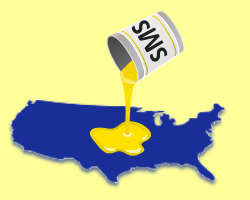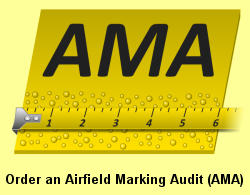 |
 |
SMS - Safety AuditsBy Mike Speidel
In 2007, while under your rock, you missed the FAA releasing an Introduction to SMS which announced the philosophy associated with the new SMS directive. In it, concepts including safety audits, gap analysis, risk assessments and training are part of the new SMS lifecycle. Over the course of 2011, I will be discussing each concept as they relate to an airfield marking system within an SMS. This article focuses on the safety audit, one of the initial components of an SMS lifecycle, and why it is critical that marking systems receive a specific safety audit.
Safety AuditsIt's such an ugly word... audit. It conjures up images of the IRS knocking on your door and turning your once happy life into a nightmare. However, in this context it isn't nearly as evil. Instead, the purpose of a safety audit is to evaluate current processes, report the findings and make informed decisions to maximize effectiveness and consequently, safety. It's simply a tool designed to identify hazards to safety in order to define and mitigate risk. As marking specialists, Sightline is very concerned with the current state of our nation's airfield markings. We're losing sleep over it; and if you know me, you know I like my sleep! When we perform airfield marking audits for our clients, we look at several factors that make up a marking's overall effectiveness. Location, dimension, alignment and accuracy in general are important, but there are several other components to consider to adequately audit marking performance. For example, a marking in proper position, within dimension and alignment tolerances may be considered as a functional marking. If that same marking is not conspicuous during low visibility or is potential FOD; it is a hazard. Based on my experiences, airports of every size are littered with these hazards. When developing safety audits, be sure not only to include airfield markings as a separate audit and define which marking characteristics will be evaluated.
|

 Unless you have been living under a rock for the last several years, you've heard about
the imminent implementation of SMS into aviation in the US. For the small percentage of you who have just
reemerged from your favorite rock; let's get you up to speed. Safety Management Systems, or SMS, is a
systematic method-based approach to identify and assess risk within an organization. In this case, the US
aviation industry will undergo an integration of current culture with new SMS procedures in the interest
of ultimately creating the safest environment possible.
Unless you have been living under a rock for the last several years, you've heard about
the imminent implementation of SMS into aviation in the US. For the small percentage of you who have just
reemerged from your favorite rock; let's get you up to speed. Safety Management Systems, or SMS, is a
systematic method-based approach to identify and assess risk within an organization. In this case, the US
aviation industry will undergo an integration of current culture with new SMS procedures in the interest
of ultimately creating the safest environment possible.
 Or you can outsource! Sightline's systematic approach to auditing markings (Marking Condition
Index©) is already being used by airports all over the nation. We not only evaluate current conditions for
functionality, we also provide solutions in the form of multi-year maintenance plans, equipment procurement,
material selection, training or whatever you need. Sightline will convince you that audit isn't always such an
ugly word!
Or you can outsource! Sightline's systematic approach to auditing markings (Marking Condition
Index©) is already being used by airports all over the nation. We not only evaluate current conditions for
functionality, we also provide solutions in the form of multi-year maintenance plans, equipment procurement,
material selection, training or whatever you need. Sightline will convince you that audit isn't always such an
ugly word!